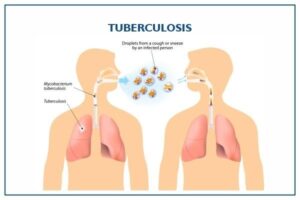Last updated on September 28th, 2024 at 10:55 am
Tuberculosis treatment stands as a beacon of hope in the relentless fight against one of the world’s oldest and deadliest infectious diseases. Tuberculosis, often abbreviated as TB, is a bacterial infection caused by Mycobacterium tuberculosis that primarily affects the lungs but can also target other parts of the body.
While TB is a potentially life-threatening disease, it is curable, and timely tuberculosis treatment plays a pivotal role in its management.
What is Tuberculosis?
Tuberculosis is primarily transmitted through the air when an infected person coughs or sneezes, releasing tiny droplets containing the bacteria. Once inhaled, these bacteria can establish an infection in the lungs. However, not everyone infected with TB bacteria becomes ill; some may develop latent TB, a condition where the bacteria remain dormant in the body without causing symptoms.
On the other hand, active TB manifests as a range of symptoms such as persistent cough, chest pain, fatigue, weight loss, and fever. This is the stage where tuberculosis treatment is crucial.
Role of Tuberculosis Treatment
Treatment for tuberculosis serves two primary purposes: curing the individual who is sick and preventing the spread of the disease to others. An effective treatment plan is not only a lifesaver but also a cornerstone in the global efforts to control the spread of the disease.
Without appropriate treatment for tuberculosis, it can become drug-resistant, making it even more challenging to manage.
Read: What are Generic Medicines?
Treatment of Tuberculosis
One of the fundamental elements is the use of antibiotics to target and eliminate the Mycobacterium tuberculosis bacteria. The standard treatment of tuberculosis regimen for drug-susceptible TB typically includes four essential medications:
Isoniazid (INH): This antibiotic is highly effective against TB bacteria and is a cornerstone of the treatment of tuberculosis.
Rifampin (RIF): Rifampin is another potent antibiotic that, when combined with INH, helps prevent the development of drug resistance.
Pyrazinamide (PZA): PZA is typically included in the initial phase of tuberculosis treatment to quickly reduce the bacterial load in the body.
Ethambutol (EMB): EMB is often used alongside other medications to further enhance treatment efficacy.
The specific combination of these drugs and the treatment duration may vary depending on factors such as the patient’s age, drug sensitivity of the bacteria, and the presence of any underlying health conditions.

What is the Treatment Plan for Tuberculosis
Developing a successful treatment plan for tuberculosis involves several key components:
- Diagnosis: The first step is accurate diagnosis, which often includes a chest X-ray, sputum smear microscopy, and molecular tests. Identifying the strain’s drug sensitivity is crucial for selecting the most effective medications.
- Medication: It usually involves a combination of antibiotics taken over several months. The most common drugs include isoniazid, rifampin, pyrazinamide, and ethambutol. Treatment must be consistent and complete even if symptoms subside before the prescribed course ends.
- Directly Observed Therapy (DOT): To ensure compliance with the treatment plan, healthcare providers often employ Directly Observed Therapy. In this approach, patients take their medications under the supervision of a healthcare worker or designated observer.
- Monitoring: Regular monitoring is vital to assess treatment progress and detect any adverse effects. Blood tests and follow-up appointments help in this regard.
- Nutritional Support: Adequate nutrition plays a crucial role in the body’s ability to fight off TB. Patients are often encouraged to maintain a balanced diet to aid in recovery.
- Infection Control: TB is highly contagious, and individuals undergoing treatment need to take precautions to prevent transmission. Good respiratory hygiene, such as covering the mouth and nose when coughing or sneezing, is essential.
> Consult a doctor and Order Medicine Online
Challenges in the Treatment
Despite the availability of effective treatment for tuberculosis, several challenges persist:
- Drug Resistance: Drug-resistant TB strains, such as multidrug-resistant TB (MDR-TB) and extensively drug-resistant TB (XDR-TB), have emerged. These strains are harder to treat and require more extended, more complex treatment regimens.
- Stigma: The social stigma associated with TB can discourage individuals from seeking treatment promptly, thereby exacerbating the problem.
- Access to Healthcare: Inadequate access to healthcare facilities, particularly in underserved regions, can hinder early diagnosis and treatment.
- Socioeconomic Factors: Poverty, malnutrition, and overcrowded living conditions contribute to the prevalence of TB, making it harder for affected individuals to adhere to treatment plans.

Conclusion:
Tuberculosis treatment is a complex process that requires a well-crafted treatment plan, dedication, and a multi-faceted approach. With timely diagnosis, appropriate medication, and support systems in place, individuals with TB can not only recover but also contribute to the global goal of eradicating this ancient disease. It is our collective responsibility to ensure that the fight against tuberculosis continues until we achieve a TB-free world.
FAQs on Tuberculosis Treatment
Q.1 What is tuberculosis treatment?
Tuberculosis treatment is a medical regimen aimed at curing the bacterial infection caused by Mycobacterium tuberculosis. It typically involves a combination of antibiotics taken over several months to ensure the complete eradication of the bacteria and prevent the development of drug resistance. Treatment for tuberculosis is essential for the patient’s health and to reduce the risk of transmission to others.
Q.2 How long does tuberculosis treatment typically last?
It usually lasts for six to nine months for drug-sensitive TB. However, drug-resistant TB may require treatment for up to 24 months, depending on the specific drug regimen and the patient’s response to therapy.
Q.3 Can tuberculosis be cured completely with treatment?
Yes, tuberculosis can be cured with proper treatment. Timely and consistent adherence to the prescribed medication regimen is crucial to ensure complete recovery and prevent the development of drug-resistant strains.
Q.4 Are there any side effects associated with tuberculosis medications?
Yes, some common side effects of TB medications include nausea, vomiting, and liver function abnormalities. However, healthcare providers closely monitor patients and can adjust the treatment plan if severe side effects occur. It’s essential to communicate any side effects promptly to your healthcare team.
Related Links: